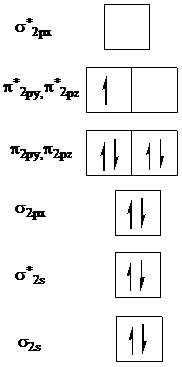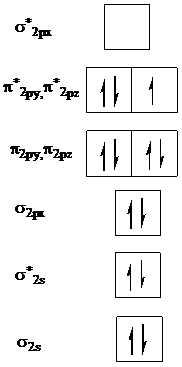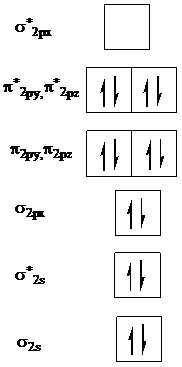
Concept explainers
Interpretation:
The bond order and magnetic properties of the given molecules are to be determined.
Concept introduction:
Two atomic orbitals combine to form a bonding molecular orbital and an antibonding molecular orbital. Orbitals that lie on internuclear axis combine to form
(sigma) molecular orbitals, and orbitals parallel to each other combine to form
molecular orbitals.
The molecular orbitals formed by the combination of
orbitals are a bonding molecular orbital, designated by
orbital forms corresponding molecular orbitals.
The molecular orbitals formed by the combination of
orbitals area bonding molecular orbital, designated by
The molecular orbitals formed by combining
orbitals are bonding molecular orbitals, designated by
and
and
Electrons are filled in the molecular orbitals in increasing order of energy.
Bond order is determined by subtracting the number of electrons in antibonding orbitals from the number of electrons in bonding orbitals, and dividing by two.
Higher the bond order, more stable is the molecule.
A diamagnetic substance contains paired electrons whereas a paramagnetic substance contains unpaired electrons.
Answer to Problem 57QP
Solution:
Bond order of
is diamagnetic and
are paramagnetic.
Explanation of Solution
The electronic configuration of an oxygen atom is
is as follows:

Now, remove one electron from
to get the molecular orbital diagram for

Add one electron to

Add two electrons to

In
In
is calculated as follows:
In
In
is calculated as follows:
A molecule of
contains two unpaired electrons,
contains one unpaired electron,
contains one unpaired electron, and
contains no unpaired electron. Thus,
is diamagnetic and
are paramagnetic.
Want to see more full solutions like this?
Chapter 9 Solutions
Chemistry
- Could the anion Li2 exist? What is the ions bond order?arrow_forwardFrom the electron-pair repulsion model, predict the geometry of the following molecules: a TeF6 b ClF5 c SeF4 d SbF5arrow_forwardIt is possible to write a simple Lewis structure for the SO42- ion, involving only single bonds, which follows the octet rule. However, Linus Pauling and others have suggested an alternative structure, involving double bonds, in which the sulfur atom is surrounded by six electron pairs. (a) Draw the two Lewis structures. (b) What geometries are predicted for the two structures? (c) What is the hybridization of sulfur in each case? (d) What are the formal charges of the atoms in the two structures?arrow_forward
- The sulfamate ion, H2NSO3, can be thought of as having been formed from the amide ion, NH2, and sulphur trioxide, SO3. (a) What are the electron-pair and molecular geometries or the amide ion and or SO3? What are the hybridizations of the N and S atoms, respectively? (b) Sketch a structure for the sulfamate ion, and estimate the bond angles. (c) What changes in hybridization do you expect for N and S in the course of the reaction NH2 + SO3 H2NSO3? (d) Is SO3 the donor of an electron pair or the acceptor of an electron pair in the reaction with amide ion? Does the electrostatic potential map shown below confirm your prediction?arrow_forwardWhich of these molecules have an odd number of valence electrons: NO2, SCl2, NH3, NO3?arrow_forwardConsider the following molecules: SiH4, PH3, H2S. In each case, a central atom is surrounded by four electron pairs. In which of these molecules would you expect the bond angle to be less than 109.5? Explain your reasoning.arrow_forward
 Chemistry & Chemical ReactivityChemistryISBN:9781133949640Author:John C. Kotz, Paul M. Treichel, John Townsend, David TreichelPublisher:Cengage Learning
Chemistry & Chemical ReactivityChemistryISBN:9781133949640Author:John C. Kotz, Paul M. Treichel, John Townsend, David TreichelPublisher:Cengage Learning Chemistry: Principles and PracticeChemistryISBN:9780534420123Author:Daniel L. Reger, Scott R. Goode, David W. Ball, Edward MercerPublisher:Cengage Learning
Chemistry: Principles and PracticeChemistryISBN:9780534420123Author:Daniel L. Reger, Scott R. Goode, David W. Ball, Edward MercerPublisher:Cengage Learning Chemistry: The Molecular ScienceChemistryISBN:9781285199047Author:John W. Moore, Conrad L. StanitskiPublisher:Cengage Learning
Chemistry: The Molecular ScienceChemistryISBN:9781285199047Author:John W. Moore, Conrad L. StanitskiPublisher:Cengage Learning General Chemistry - Standalone book (MindTap Cour...ChemistryISBN:9781305580343Author:Steven D. Gammon, Ebbing, Darrell Ebbing, Steven D., Darrell; Gammon, Darrell Ebbing; Steven D. Gammon, Darrell D.; Gammon, Ebbing; Steven D. Gammon; DarrellPublisher:Cengage Learning
General Chemistry - Standalone book (MindTap Cour...ChemistryISBN:9781305580343Author:Steven D. Gammon, Ebbing, Darrell Ebbing, Steven D., Darrell; Gammon, Darrell Ebbing; Steven D. Gammon, Darrell D.; Gammon, Ebbing; Steven D. Gammon; DarrellPublisher:Cengage Learning Chemistry: Principles and ReactionsChemistryISBN:9781305079373Author:William L. Masterton, Cecile N. HurleyPublisher:Cengage Learning
Chemistry: Principles and ReactionsChemistryISBN:9781305079373Author:William L. Masterton, Cecile N. HurleyPublisher:Cengage Learning Chemistry & Chemical ReactivityChemistryISBN:9781337399074Author:John C. Kotz, Paul M. Treichel, John Townsend, David TreichelPublisher:Cengage Learning
Chemistry & Chemical ReactivityChemistryISBN:9781337399074Author:John C. Kotz, Paul M. Treichel, John Townsend, David TreichelPublisher:Cengage Learning





